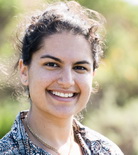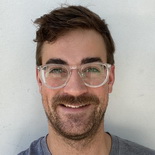
The Scholarship recipients 2020 Information is from the applications
Sarah Gaffney, University of California, Davis, Ecology
Sarah is studying California's grasslands, which she notes "are one of the most invaded ecosystems in the world--90% are dominated by Eurasian grasses, with native grasses existing only in remnant populations." Native restoration is taking place across California, but restoration is expensive, and many of these restoration projects fail.
Her research, which focuses on 12-year-old experimental plots, aims to answer the following questions: Is there a time limit to native restoration before the site becomes invaded again? If so, can we predict which non-native species will invade and when? Finally, restoration occurs on previously invaded soil--can changes to the soil caused by invasive species affect restoration success?
Sarah wants to be a scientist who collaborates with managers on issues important to them in order to improve their success rate. To improve her outreach, she joined the board of the California Native Grasslands Association. To inspire budding young scientists, she has worked with high school students on local restoration projects.
Nathan Gamarra, UC San Francisco, Biochemistry and Biophysics - Hendess award
Nathan is working to understand the "fundamental principles of how cells establish and maintain their identity. Cells control their fate by finely tuning the activity of genes at the molecular scale. The precise mechanisms by which cells accomplish this difficult task remain poorly understood." He is hopeful that the findings of his research will both "deepen our appreciation of the sophistication of biology at the molecular level" while also "providing new basic principles for the understanding of diseased cell states" and thus inform "the development of new innovative therapeutics."
Because of his passion for teaching and "communicating the joy of exploration and discovery," he plans to make teaching and scientific outreach part of his future career. He is already well on his way. As one of his professors noted, "Nathan has been a dedicated mentor to many rotation students" and has received "glowing recommendations from the students about his teaching abilities."
Dominick Lawton, UC Berkeley, Slavic Languages and Literature - Gilliland award
Dominick's dissertation, "Making Things Matter: The Poetics of Materialism in Russian Revolutionary Literature, 1909-1939," addresses the question of the relationship between literature and the material world. It serves to bridge Slavic Studies to the growing body of theoretical work on "new materialism" and offers a fundamentally new take on early Soviet literature. Although literature is at the center of Dominick's project, he draws on a wide range of non-fictional material--economic treatises, interviews, memoirs, journalism, and the like.
He was the first graduate student in years to teach BCS (Bosnian-Croatian-Serbian) and designed and taught a range of classes at Cal. His aim is to "build understanding of Slavic culture cultures today and raise the profile of past links between Slavic culture and the rest of the world," to "push against treating the Slavic world as an aberration, instead emphasizing its exchanges with global culture."
Matthew Libassi, UC Berkeley, Environmental Science, Policy, and Management
Matthew Libassi, UC Berkeley, Environmental Science, Policy, and Management
"(In)formal Entanglements in Indonesia's Overlapping Extractive Landscapes"
Matthew is examining disputes over small-scale gold mining in West Java, Indonesia. Many scholars and institutions have turned their attention to small-scale mining, but attempts to reform the sector have historically failed: the informal gold economy has persisted for a quarter-century. Matthew's work focuses on the social and political reasons for these failures. He examines "the historical contexts and socio-political relations in which mining is embedded."
He spent a year living with the miners in West Java, conducting "80 semi-structured interviews" and filling notebooks with "observations about mining practices and mining politics." New technology and more capitalization have not improved the life of the small-scale miners. Instead, economic power has been readily converted into social influence and consolidated. "Everyday mining participants, in contrast, have borne the brunt of increased policing while having limited access to new efficiencies."
Jacob Moe-Lange, Stanford, Biology
"How have herbivores, ranging from herds of bison to locust swarms, refrained from eating all of the plants that surround us? . . . Might the plants be whispering about us?" Jacob is studying this "whispering"--electrical signaling by plants. Using electrophysiological techniques, he has screened through a collection of candidate mutants in genes that he hypothesizes are involved in wound signaling. As he notes, "Progress in our understanding of electrical signaling has the potential to yield huge applied benefits. Imagine if farmers could 'listen' to their plants." They could identify stresses and pest problems much earlier than current methods allow and take corrective action sooner.
In pursuing his research into the molecular mechanisms whereby plants sense and respond to injury, Jacob has had to build many of his own tools, including his own apparatus for electrophysiology and his own microscope, based on a decommissioned DNA-sequencing machine. In looking for answers, he is, as one of his professors noted, "consistently asking questions about biology puzzles that have been left unexplored." He aims to continue the questioning.
Anna Nisi, UC Santa Cruz, Environmental Studies - Reed award
Anna is studying "the movement ecology and population dynamics of pumas . . . living in the Santa Cruz mountains," the backyard of Silicon Valley and San Francisco, home to hundreds of thousands of people. She is particularly interested in how behavior can allow pumas to survive alongside humans. Large carnivores try to avoid risky places, but "these risk cues can become decoupled from actual risk." In the case of the pumas under study, the "riskiest" places were not the places the pumas avoided but the ones they selected.
Urban land use policies have driven habitat fragmentation. In her study, therefore, Anna is also assessing "whether policies encouraging low-density development in the city of Santa Cruz produced exurban sprawl in neighboring areas and negatively impacted wildlife habitat connectivity." Urban land use policies have to be considered when conservation policies are being developed.
Mark-Phillip Pebworth, UC San Francisco, Biomedical Sciences.155 - Hardardt Award
Mark-Phillip is studying human neocortical development. "Within each cell," he writes, "DNA is entangled like a knot of twine, full of coils and loops. This structure is important, and these loops regulate the amount of gene activation by physically connecting a given gene with a regulatory genetic sequence, called an enhancer. This dynamic complicates the study of genetic diseases."
Mark-Phillip created a cell-type specific enhancer-gene map for the developing brain. In analyzing the data from his research, he and colleague found new implications for Alzheimer's treatment and "a surprising discovery related to human evolution." In summary, he created a novel cell isolation method, built a comprehensive resource for the broader biomedical community, and discovered evidence for the etiology of Alzheimer's and human-specific traits in the human cortex.

Sabrina Shirazi--UC Santa Cruz; ecology and evolutionary biology -Norall Award
Sabrina is using "environmental DNA" (eDNA), which refers to DNA shed by organisms into the soil and water, to discover what organisms live with an ecosystem. The common approaches do not detect bacteria or most fungi, so important parts of the ecosystem are ignored. Her dissertation focuses on "developing our understanding of eDNA and using it to understand ecosystem dynamics." Two of her studies use eDNA to understand how ecosystems respond to stressors. Another two use eDNA isolated from ancient soils spanning thousands of years to understand "the timing of human arrival on the Faroe Islands and their influence on the ecosystem, and how plant and mammal communities shifted and were correlated during the Pleistocene to Holocene transition."
Part of her research examines the effects of fire--necessary in Mediterranean biomes such as California to sustain biodiversity. Environmental DNA is "the only single monitoring tool that can be used to simultaneously survey all taxonomic groups within a system. . . . By applying eDNA to studies on fire, we will observe fire effects on macro and micro organisms and on the functional networks within a community that may underlie its health and functioning."


